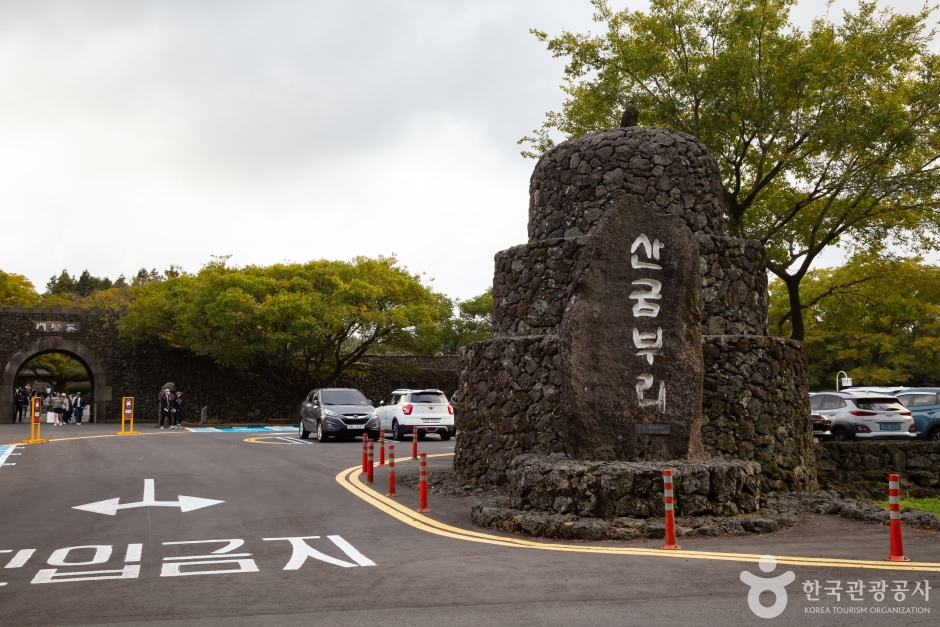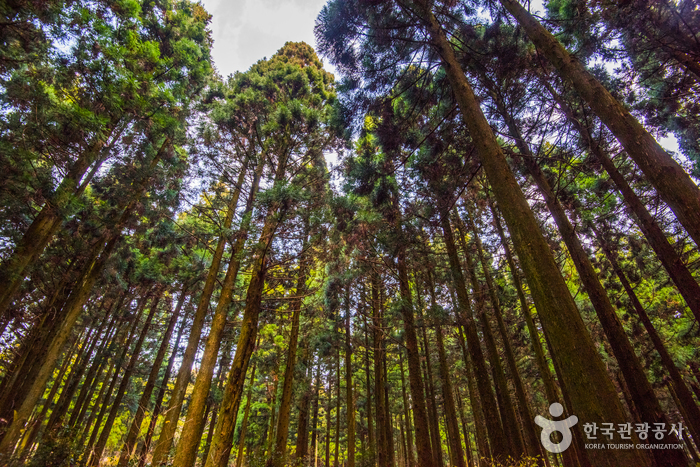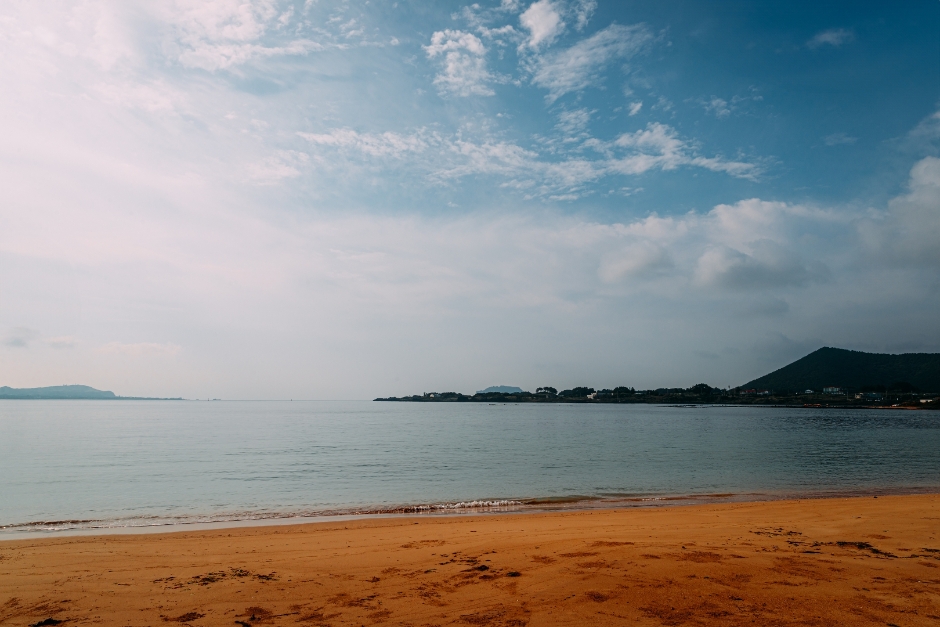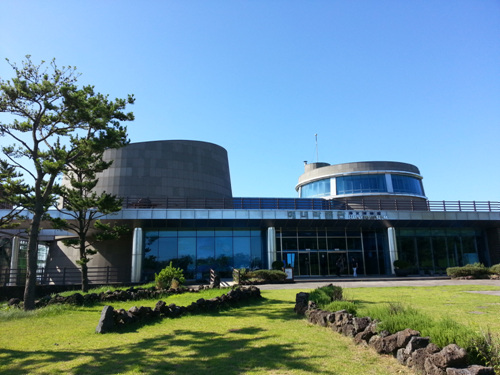Haenyeo Kitchen (해녀의 부엌)
14.4Km 2025-10-31
2265 Haemajihaean-ro, Gujwa-eup, Jeju-si, Jeju-do
Haenyeo Kitchen is a local food dining space where visitors can enjoy dishes handmade by Jeju's haenyeo (female divers) and performances that unfold their stories. Housed in a renovated old warehouse by the sea, visitors can savor meals prepared by the haenyeo themselves, using Jeju's seafood and bountiful ingredients. The performances here showcase the talent and dedication of young artists working across diverse fields, from spatial design and story development to planning, lighting, music, choreography, and acting, allowing visitors to fully immerse in the world of haenyeo.
Sangumburi Crater (산굼부리)
14.5Km 2024-11-28
768 Bijarim-ro, Jeju-si, Jeju-do
+82-64-783-9900
Sangumburi Crater has been designated as a Natural Monument. It is located on the southeast side of Jeju, and is a flat crater, about 650 meters wide, 100 meters deep, and 2,070 meters in circumference. If you look at the crater from above up, it looks like a man-made circular stadium. There is a variety of plant-life in the crater. On the north side, Nandaeseong vegetation such as red-thorn trees, and magnolia trees grow, along with the rare winter strawberries. On the south side of the crater, Ondaerim vegetation such as evergreens, maples, and mountain strawberry trees cover the area. Because so many different kinds of trees and plants grow in such a limited space, it attracts the attention of researchers as well.
Saryeoni Forest Trail (사려니숲길)
15.0Km 2025-10-23
Entrance of Bulgeun Oreum, Gasi-ri, Seogwipo-si, Jeju-do
+82-64-900-8800
Saryeoni Forest Trail cuts through the dense Japanese cedar forest growing between Mulchat Oreum and Saryeoni Oreum, starting from the entrance on Regional Road 1112. While the vast majority of the trees growing here are Japanese cedar, visitors can also see Japanese oak, birch, snowbell trees, and cypress trees along this 550-meter-long trail. The forest trail is known as one of Jeju's top 31 hidden attractions, and is well-known as being very protected. It is very popular among tourists who enjoy hiking and the outdoors.
Hado Beach (하도해변)
15.5Km 2025-10-27
1973 Haemajihaean-ro, Gujwa-eup, Jeju-si, Jeju-do
Located by the roadside of Hado-ri, known as the most beautiful coastal road in Jeju, Hado Beach is relatively quiet compared to other beaches in Jeju, featuring wide sandy beaches and clear, shallow waters. The gentle scenery unfolds with calm waves, making it suitable for marine leisure activities such as snorkeling and kayaking. Like Rain and Noh Hong-chul in "The Hungry and the Hairy," you can spread a simple table and chair and enjoy a cup of coffee quietly.
Cheonjin Port (천진항)
15.6Km 2023-02-16
1737-15, Yeonpyeong-ri, Jeju-si, Jeju-do
+82-64-740-6000
Udo Island is the largest of all the smaller islands near Jeju and where the sun rises before anywhere else. It is located at the eastern end of Jeju Island and a popular tourist spot that is always crowded with visitors as there are numerous things to see, eat and enjoy. The island is a bit too big to tour on foot so it is better to enter the island by car, rent an electric scooter or a small electric vehicle once on the island or travel by bus. Udo has two docks located at Cheonjin Port and Haumokdong Port. Cheonjin Port is the gate port into Udo with several electric scooter rental shops, so many tourists get off here. It takes about 10 to 15 minutes from Seongsan Port or Jongdal Port to Cheonjin Port.
Olive Young - Jeju Sehwa Branch [Tax Refund Shop] (올리브영 제주세화점)
15.7Km 2024-06-27
1F, 3126, Iljudong-ro, Gujwa-eup, Jeju-si, Jeju-do
-
Jeju Olle Trail - Route 1-1 (Udo Island Olle) ([제주올레 1-1코스] 우도-올레)
15.8Km 2021-07-02
1737-1, Yeonpyeong-ri, Jeju-si, Jeju-do
+82-64-762-2190
Shaped like a cow lying down, Udo Island with its clean green fields, stonewalls, and striking lighthouse presents some of the best scenery in the Jeju area. Udo is the largest of the 62 islands that surround Jeju, and boasts indigo blue sea throughout the year. Visitors can enjoy beautiful views as they walk the Olle trail that includes seaside, plantation fields, green pastures, and Undobong Peak.
Haenyeo Museum (해녀박물관)
15.9Km 2025-03-15
26 Haenyeobangmulgwan-gil, Gujwa-eup, Jeju-si, Jeju-do
+82-64-782-9898
The culture of Jeju's female divers, known as haenyeo, which has been inscribed as a UNESCO Intangible Cultural Heritage of Humanity. It exhibits the history of Jeju's haenyeo culture dating back to ancient times, with all the exhibits donated by the haenyeo themselves. The museum even features a replica of a haenyeo's house and provides detailed exhibitions on their food culture, upbringing, semi-agricultural and semi-fishing culture, yeongdeunggut, and more.
Sehwa Beach (세화해변)
16.0Km 2023-01-17
Sehwa-gil, Jeju-si, Jeju-do
+82-64-740-6000
Sehwa Beach, located in Sehwa-ri in Gujwa-eup, is a white sandy beach with black basalt that harmonizes perfectly with the emerald waters. Sehwa Beach is well-known in Jeju Island due to its close proximity with Bellongjang Market and Sehwa Folk Fifth-day Market, opening right next to Sehwa Beach, as well as the flea market at Bellongjang Market attracting many visitors.
Hundert Wasserpark (훈데르트바서파크)
16.0Km 2024-02-20
32-24 Udohaean-gil, Udo-myeon, Jeju-si, Jeju-do
Hundert Wasserpark is a cultural space devoted to the Austrian artist Hundertwasser, known for his pursuit of harmony with nature. It encompasses a museum that displays the artist's life and his contributions to painting, architecture, and sculpture. Additionally, the park includes the Udo Gallery, showcasing works by emerging artists centered on the theme of Jeju, as well as a gift shop. The entire park, designed as a work of art, seamlessly integrates with Udo Island, serving as a vast photo zone that embodies this harmony.





 English
English
 한국어
한국어 日本語
日本語 中文(简体)
中文(简体) Deutsch
Deutsch Français
Français Español
Español Русский
Русский